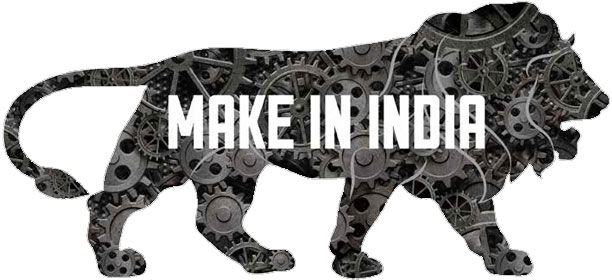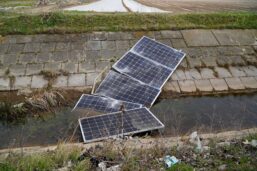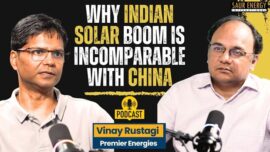

Innovation in Finance
When asked about the direction of innovation in financing for clean energy Manish Chaurasia, Managing Director, Tata Cleantech Capital Ltd. (TCCL) said, there is a lot of innovation happening in clean energy financing on a global scale. From securitization of assets to setting up of yield to monetize and plough back capital, there have been many new instruments to innovate investment. He added, clean energy projects, once operational, offer predictable cash flows and require minimal intervention for their long life of 25 – 30 years and thereby constitute the perfect opportunity for long term investors expecting steady cash flows.
To address this investor market, there have been various initiatives like credit rating enhancement and infrastructure debt funds which attempt to widen the investment pool to pension and insurance funds. This is expected to substantially boost the funds available for deployment to the sector said Chaurasia. He noted green bonds and special funding lines from overseas investors towards clean energy and specifically solar rooftop and energy efficiency sectors are innovative means to boost investment in the sectors.
Challenges
Solar energy in India has witnessed quite a shift in the market in last few years and has brought lot of challenges for EPC players, manufacturers, developers and financers in this segment. Speaking about the challenges Anupam Dhiman said, although, progress is being made; there are challenges to be handled. Offering flexible incentives and financing options, slow net metering implementation time frame, imposing anti-dumping on foreign solar modules (India spent $1.3 billion in 2015-16 in imports), consistent decrease in announcement and awarding DCR projects, enforcing solar installations on buildings, establishing more module assessment labs (currently India has 5 MNRE accredited labs), delay in awarding contracts 9 out of 12 GW of bids conducted in the FY 2016-17 so far, only 4 GW has been awarded), delay in new manufacturing policy implementation, continuously falling discount in tariffs, lack of solar skill development etc. need prompt response from Government to bring comprehensive socio-economic growth in the country through solar development, said Dhiman.
On the other hand Manish Chaurasia said, there has been a lot of enthusiasm in the solar energy sector in India in the past year. This is partly on account of increased investment in the sector, particularly from overseas investors. Another factor is the increasing optimism among the Indian lenders possibly due to a mix of better understanding of the sector and increased funds available for deployment. In addition, there has been a reduction in solar panel costs prompting aggressive bidding in reverse auctions resulting in tariffs falling to a record low of Rs 2.44/unit in the SECI bid for Bhadla Solar Park in Rajasthan in May 2017. However, any volatility in the price of solar modules will pose a key challenge in the sector. We also foresee that the solar module prices in the short term may not fall at the pace anticipated and estimated by project developers.
Chaurasia notes that while these factors have resulted in an optimistic investment climate with more players entering the market, there are significant pricing pressures being experienced in project financing. It has become all the more critical for lenders today to ensure no compromise in the quality of project components and execution. GST implementation was yet another factor which hit the industry in the past year. The cost of solar projects went up by around 10-12% on account of increase in taxes. Proactive monitoring and actions helped us navigate through the GST implementation without much ado.
The biggest challenge in the renewable energy sector, as we see it, is the potential of reneging of contracts and power purchase agreements by the DISCOMs. Hence, it is extremely critical for the Government to maintain the sanctity of the executed contracts and tariffs for the sector to continue to grow and flourish in India. In addition to the challenges mentioned above, some key challenges like land availability / ownership have persisted owing to availability of contiguous land parcels being a pre-requisite for solar energy and hence, the high impact of risk involved. Grid connectivity, grid availability and evacuation infrastructure being in place continue to remain key challenges in the renewable energy sector. Availability of water, especially for O&M for solar projects, is yet another challenge added Chaurasia.
Dharmesh Tanti notes that policy and purpose, both are reasons for this shift of gears in the Indian Solar industry. Federal Policy provided the much required impetus to renewables, particularly Solar. On the other hand input cost reductions provided better viability for solar project investors, who have made investing in sustainable energy part of their overall purpose to support the environment and health.
As I see, there are two major challenges ahead for EPC- 1) Short to medium term volatility in module & commodity prices; pose financial risk to EPC contractors who bagged fixed price orders based on current/projected aggressive prices and 2) Buyer’s remorse to already ordered or under development projects, due to short term fall in input said Tanti.
Ashish Khanna said, we believe the domestic manufacturing has the potential to play critical part in the success of Jawaharlal Nehru Solar Mission. The sector has seen aggressive growth lately. India registered 145% growth in 2016 with total solar capacity addition of more than 5 GW. New capacity addition of around 9 GW is forecasted for 2017. This shall make India the third biggest solar market worldwide. He added, in India, people have ‘assumed certain costs’. However, cost is actual whereas price is strategic. On the cost front, domestic modules are working capital costs and disadvantageous to some extent because of the scale, and subsidies provided to the Chinese manufacturers in form of power, land costs etc.) Having said that, we need to question and understand if it is the cost differential or price differential between us?
Khanna further stated that there has also been limited investment in manufacturing sector for quiet sometime which is not helping us to grow in scale. Compare this to the increasing domination of Chinese in the solar panel market. It is not more than 10 years old phenomenon i.e. a very recent development. This has been possible with the help of strong governmental support. That said it is imperative to create awareness among masses and stakeholders on the quality of the product. We need to understand that there is a gap between imports prices into India and import prices of other countries. We have been informed that even within China, the price of solar module is higher than its price in India. This sort of pricing is possible only in case of strategic sale or distress sale – both of which are not favorable since we consider 25 years of life cycle for modules. Consumers must be aware that the most important repercussion of low quality wafers decrease life of the modules and consequently lower return on their investment. Lack of robust contractual obligations with any supplier can also play out to be a major roadblock in Indian solar dream.
In last 2 years, Indian manufacturers heavily dependent on DCR. However, in the absence of the revenue policy framework which incentivizes the manufacturing of not only cells and modules but PUE wafers as well as a sustainable pipeline will help manufacturers to further invest in capacity and technology enhancement, said Ashish Khanna.
Speaking about the challenges Sachin Jain stated, currently due to newly introduced GST regime, there is still some different interpretation among the solar industry suppliers, manufactures, EPCs and developers. For e.g. for projects where modules are in scope of EPC and where it is only Balance of Plant. We see it would take another month or so to get the clarity on this issue.
Simarpreet Singh stated, Hartek Power is essentially Engineering, Procurement and Construction (EPC) company with expertise in executing high-voltage substation turnkey projects and connecting solar power to the grid. Held in high esteem for timely execution of projects and high quality standards, Hartek Power provides complete EPC solutions on substations and transmission lines to the industry, independent power producers and utilities. We act as a single point of contact for getting all approvals and clearances. Procedural delays by state DISCOMs can come in the way of project deadlines, which are extremely crucial when it comes to solar. The utilities should come up with a mechanism to expedite the processes so as to ensure timely completion of all projects. He further added that the rooftop segment also presents its own set of challenges. The main reason why rooftop solar has not really picked up in India as compared to groundmounted solar is lack of awareness about its immense scope and advantages to the end user. There are so many overzealous smallscale players in the integration business who commit more than what they can comfortably deliver, leaving the end consumers confused. Concerted awareness programmes can go a long way in checking this trend.
Specialized manpower is another big challenge. Considering the unprecedented pace at which the Indian solar industry continues to grow, there is a need to give due importance to proper training and utilization of manpower said Singh.
Suggestion To Support Market Growth

Manish Chaurasi believes, in order to support market growth, it is critical for the interests of all stakeholders to be protected and for the processes to be transparent. The government should continue to take a holistic long-term outlook to the industry and should not focus on short term gains. He said, the policy makers would do well to ensure that the power purchase agreements and other critical approvals like those for power evacuation or capacity allotment are honored for the entire term of the agreement. Increasing the clarity and transparency in the clearance processes in addition to decreasing the time taken for according clearances will help accelerate project execution and hence prevent delays.
Going forward, significant capacity addition is expected to happen in solar parks. Attractive bid structures with deemed generation, support in evacuation infrastructure and land etc
will help drive timely project execution and boost investor confidence, said Chaurasia. He further added, must-run status is critical for renewable energy sector due to inherent variability in production due to variance in resource availability. Hence upholding the must-run status is critical for the sector. The Government should introduce policies to protect the interests of the Indian solar developers against any renege on contracts executed with overseas solar module suppliers. This will help achieve certainty on project cost and hence alleviate lender concerns around cost over-run. Clarity on net metering scheme can provide boost to the solar rooftop sector.
Open access policies should be redesigned to incentivize the move to carbon-free renewable energy. Some states like Karnataka have very favorable open access policies, he added.
According to Anupam Dhiman, policy aid by Government has given support to Indian solar growth. He said- reaching 13 GW in 2017 is an incredible feat for a country like India, which lack industrial infrastructure like China, US and other dominant countries in the solar sector. However, as an Indian module manufacturer we would implore Government of India to look at the benefits of focusing on increasing domestic manufacturing. Policies bringing more projects, better financing options, and subsidies for domestic manufacturing would create more employment, reduce import expenses, and allow independent socio-economic growth of the country. On the other hand Dharmesh Tanti notes that the policy impetus was timely, however unclear Open Access policy and Net Metering policy in certain states is holding back business growth potential and wider adoption of Solar Energy.
Sachin Jain said, the minimum project size of a solar project has been continuously increasing in the last 4 to 5 years. Now average project size has reached minimum size of 50 MW, said Jain. He added, this typically results in only 3 to 4 developers winning the project and very few companies in the value chain get the benefit. It would be better to auction projects where max size of a project is 10 MW. This would create a more dynamic and sustainable marketplace where several players can take place and industry can bloom further.
According to Ashish Khanna, the industry is going through unprecedented growth. It continues to be a strong year for solar and is in line with the Government solar mission. However, the Indian solar PV manufacturers are facing challenge primarily due to inflow of cheap imports. He added, it is imperative for government and the industry to work together to address basic concerns that challenges the sector now.
- Focus on Quality: Critical is to ensure quality is not compromised due to singular focus on lower tariff. Current reverse bidding has certain checks and balances, but considering the 100% upfront CAPEX of solar projects and the long-term viability, it is critical that more emphasis is given to long-term quality and sustainability.
- Focus should be on Rooftop business: There is also merit in a concerted effort to build higher awareness among end-users as universal acceptance of solar is critical for it to transform into a more robust industry that is not dependent on subsidies and grants. We should develop a model for developers as well as DISCOMs and considering the quality imperatives which are difficult to be checked by individuals, this sector should be reserved for Indian manufactured products.
- Boost to manufacturing: We are very committed to ‘Make in India’ initiative and anticipate more focus on developing strong and robust manufacturing sector. Not only can manufacturing help us in becoming selfreliant from energy, but it has the potential to generate employment, boost exports and thus bring Forex and therefore contribute to the overall growth of the economy.
- Investment in Technology: Indian government has been instrumental in giving the much needed aggressive push to the sector in the initial phase. Now the need is to focus on building and strengthening the domestic solar ecosystem and technology which is best suited for Indian requirements. There should also be a level-playing field for all the players in the market. For this certain fundamentals need to be rectified to set the sector in the right trajectory. We all understand that subsidy model is not a sustainable model in the long term. Investment in technology to the extent that it can compensate for the advantage garnered by subsidy is the key. A policy framework that aligns the alternative sources of energy with due consideration to the environment needs, to cater to the country’s base load is the need of the hour.
MNRE should continue the critical role of policy formulation role with central and state controllers to guarantee that the process of tariff adjustment is as smooth as could be expected under such circumstances, said Khanna.
According to Simarpreet Singh, the government should formulate consistent longterm policies which boost investments in renewable energy. It should make it a point to collaborate more effectively with the private sector so as to build the T&D infrastructure for solar projects on a war footing. In order to increase participation of the private sector, the government should come up with sustainable energy policies, backed by financial support. To boost the morale of private players, state utilities should make timely and assured payments to them. Rooftop solar in India has a bright future in view of favorable government policies, streamlined processes, an efficient regulatory mechanism and an investor-friendly business environment. The government must also realize that net metering offers the biggest opportunity, but net metering policies are not being implemented at the ground level. Most of the installations till date have come from schemes for government-based projects. Commercial and industrial installations have gained momentum in only the last two years, said Singh. He further stated, residential rooftop is still in its nascent stage. A lot of effort is required in terms of policies and business models for this particular segment to pick up growth. Residential market is expected to pick up in the coming years on account of better policy support and lowering of solar capital costs.
Current Trends
Sharing his perspective on the current trends in solar PV industry on a global scaleAnupam Dhimansaid, global solar industry will see increase in new procurement methods like tendering and auctions. India, Latin America and other new and emerging markets will show incredible growth this year, leading world solar capacity up to more than 8 % from the previous year. Unlike 2016, demand in 2017 will increase bring stability to module prices. Last quarter of 2017 is expected to raise the demand for not just countries like India and Japan (enjoy moderate to high demand all year), but also for China, and Europe.

O&M market is suspected to see considerable increase, highlighting global urgency to establish solar energy as a stable mainstream energy. Although, the expectancy of witnessing ground breaking technology in solar industry this year is slim, 1,500V PV system will become the new trend globally, said Dhiman. He no-ted, US abandoning its commitment to the Paris Agreement did create a few swirls in the industry, but the market has revived from the shock and moving forward, which is what it is expected to do rest of the year, with global acceptance and eagerness backing the growth. Manish Chaurasi expects the total global solar PV installed capacity to continue its growth trajectory with China still leading the pack and India at number four in installed capacity by the end of 2016. He said, tough there is stagnation due to policy pullbacks across major markets including China, Japan, the USA and most parts of Europe, the demand is picking up and is expected to get back on track by the end of the year. We see that the auction route of tariff determination is gaining universal acceptance. Bridge to India estimates that the number of countries using auctions to allocate solar capacity has increased from 14 in 2014 to 22 in 2016.
While solar module prices fell at unprecedented rates in FY17, the rate of fall has decelerated over the last couple of months on account of increasing global demand and oligopoly in the Chinese market. In fact, certain Chinese module manufacturers are attempting to negotiate increase in module prices even for executed module supply agreements, said Chaurasia. He further added; while developed countries are shifting towards utility scale projects, emerging markets see their governments trying to encourage more rooftop solar growth. In India, rooftop solar has maintained a 10-12% share of overall solar capacity, which is much lower than other key markets such as US, Germany, China, Spain and Australia.
According to Dharmesh Tanti technically two aspects will play a major role in exploding the Solar PV market. First, solar module efficiency is projected to improve further with technological advancements in cell structure and module design. This will lead to better Solar PV project economics and better land utilization, which is a key resource. Second, Energy storage, specifically battery, is a synergistic solution. Cost effectiveness of PV coupled with controlled power dispatch ability of battery can provide firm power, and can replace conventional energy sources. This will also open up the micro-grid potential globally. He further stated, within the next decade, Solar PV hybrid energy systems will revolutionize the way we experience energy, it will be both clean and abundant.
Talking about the current trends in solar PV industry on a global scale Ashish Khannasaid Solar is a sunrise industry globally and the world is moving towards increasing solarization. The future of solar is bright. PV + storage will dominate the energy supply in most locations in the world. Solar with storage together constitute the parallel and intertwined revolutions that are set to transform our energy system worldwide. He further stated, attaining energy security while balancing energy demand is a critical aspect. India has always been an enthusiastic supporter of renewable energy and the national target to generate 53% of power from non-fossil fuel sources by 2027 and targets under Jawaharlal Nehru National Solar Mission is testimony to our leadership conviction in working towards clean energy.
There is an increasing competition in the solar PV market both in terms of expanse and penetration, impacted by low cost of panels. The levelized cost of energy (LCOE) has dropped down by almost 60%. According to some reports, the share of renewable energy in the global energy basket stands at 40% and going by the current wave, it should increase further with China becoming the biggest contributor to this growth by 2035, said Khanna. Sachin Jain notes that Oriano is seeing increased adoption by Commercial & Industrial (C&I) consumers as solar power is helping them reduce their electricity bills by 20% to 30%. Solar power has now reached a level where it doesn’t need any subsidy support and is comparatively cheaper than existing electricity tariffs which the industries pay for. Hence, we are seeing the C&I market is opening up rapidly where end-consumers can put the project either on their Rooftop, or on their own ground premises or through open access through transmission networks and get solar power which is cheaper than their electricity bills.
Simarpreet Singh pointing out at the new trend in module efficiency and storage said, a lot of R&D is taking place the world over to come up with more efficient solar modules, and the results have been quite encouraging. As for energy storage, lithium ion batteries are still the most preferred. He added, the concentrated solar power (CSP) technology is also gaining acceptance in view of its remarkable efficiency.
Make in India Success
Make in India is obviously announced with the idea of building industrial infrastructure in India which will in turn drive socio-economic growth. And Indian solar industry’s leap from 5 GW in 2015 to 13 GW in 2017 shows Government’s support behind the growth. However, to be truly successful, Make in India venture has to be more focused on solar domestic manufacturing said Anupam Dhiman. He noted, as Indian solar industry is rapidly becoming a considerable job creator, the industry has the potential to help solve the employment problems in the country, which is what Make in India’s true purpose is. Dhiman further stated, allowing domestic manufacturing to grow in Indian solar industry can improve Indian energy scene, provide employment and save huge amounts of money from going to import expenses. So, although successful, India needs to use Make in India to develop domestic manufacturing strength to make the venture a true success.
Speaking about the success of government’s “Make in India” initiative Ashish Khanna noted, India has sturdy manufacturing base that should be able to propel ‘Make in India’ campaign to its fruition. In this context government’s impetus in terms of tax incentives, land acquisition and building of favorable ecosystem for the sector can play significant dividends. He added, it is ironical that while Indian solar sector is seeing explosive growth, the domestic manufacturing sector has not been able to grow with the similar trajectory. Some views that the Indian solar growth is being fueled by cheap imported solar modules while the Indian units are closing down due to falling customer base. Solar has long way to go and if certain fundamentals can be rectified to enable a level playing field for the domestic sector, it can surely be a game changer for increasing deployment of made in India products.

Khanna further said, rooftops will be cri-tical for bridging the current energy divide and also ensure larger adoption of solar at a consumer level. Rooftops also have the highest capacity to generate employment and make the industry increasingly independent of policy support. While policies like net metering have been employed across most states, there is a need for effective implementation and roll-out to encourage the end-customer to adopt clean energy.
- High Quality: We need better checks and balances to ensure quality for long term viability of the plant. The need for quality standardization is critical, to ensure there is no compromise on the output, given that most solar modules have a 25 years’ warranty. With low entry barriers, there is scope for inexperienced players to enter the market, and dilute the long term impact of solar by focusing on short-term gains.
- Focus on distributed generation: Prominence on large grid connected solar projects has helped in achieving our solar growth numbers. However, true impact of solar will be visible by driving distributed generation like solar rooftops. While policies like net metering have been employed across most states, their implementation and roll-out needs that the end-customer is encouraged to adopt clean energy.
- Building awareness: There is also merit in a concerted effort to build higher awareness among end-users as universal acceptance of solar is critical for it to transform into a more robust industry that is not dependant on subsidies and grants.
- Operations & Maintenance Needs: Once the rooftops will grow the requirement of O&M will also witness exponential; growth and hence a reliable O&M system needs to be in place.
- Skill development: We must invest in skill development and trainings to brush up industry new technologies.
For the domestic sector technology hasn’t been the major problem, it is the drying up of pipeline that has hit the business in its budding stage. Consequently, lack of ramping up of capacity further results in short supply of domestic modules in the market. This is a vicious circle.
Domestic cell manufacturing is also dependent on external forces and import wafers and in that sense we need to holistically develop domestic ecosystem to take full advantage of this unprecedented business opportunity said Khanna.



























